Time-Budget of Horses Reared for Meat Production: Influence of Stocking Density on Behavioural Activities and Subsequent Welfare
Simple Summary
Abstract
1. Introduction
2. Materials and Methods
2.1. Animals and Animal Husbandry
2.2. Selection of Group Pens
2.3. Behavioural Observations
2.4. Data and Statistical Analysis
- -
- 24 h periods (%/24 h);
- -
- 12 daylight hours (8:00 am–8:00 pm) (%/daylight hours);
- -
- 12 night hours (8:00 pm–8:00 am) (%/night hours).
2.4.1. Correlations between Time-Budget and Stocking Densities within Group Pens
2.4.2. Overall Time-Budget and Time Frame
3. Results
3.1. Correlations between Time-Budget and Stocking Densities within Group Pens
3.2. Overall Time-Budget and Time Frame
4. Discussion
5. Conclusions
Author Contributions
Funding
Conflicts of Interest
References
- Belaunzaran, X.; Bessa, R.J.B.; Lavín, P.; Mantecón, A.R.; Kramer, J.K.G.; Aldai, N. Horse-meat for human consumption—Current research and future opportunities. Meat Sci. 2015, 108, 74–81. [Google Scholar] [CrossRef]
- Lorenzo, J.M.; Sarriés, M.V.; Tateo, A.; Polidori, P.; Franco, D.; Lanza, M. Carcass characteristics, meat quality and nutritional value of horsemeat: A review. Meat Sci. 2014, 96, 1478–1488. [Google Scholar] [CrossRef]
- De Palo, P.; Maggiolino, A.; Centoducati, P.; Tateo, A. Slaughtering age effect on carcass traits and meat quality of italian heavy draught horse foals. Asian-Australas. J. Anim. Sci. 2013, 26, 1637–1643. [Google Scholar] [CrossRef]
- FAOSTAT. Available online: http://www.fao.org/faostat/en/#data/QL (accessed on 19 November 2019).
- Tateo, A.; De Palo, P.; Ceci, E.; Centoducati, P. Physicochemical properties of meat of Italian Heavy Draft horses slaughtered at the age of eleven months. J. Anim. Sci. 2008, 86, 1205–1214. [Google Scholar] [CrossRef]
- Raspa, F.; Tarantola, M.; Bergero, D.; Bellino, C.; Mastrazzo, C.M.; Visconti, A.; Valvassori, E.; Vervuert, I.; Valle, E. Stocking Density Affects Welfare Indicators in Horses Reared for Meat Production. Animals 2020, 10, 1103. [Google Scholar] [CrossRef]
- Blanco-Penedo, I.; Ló Pez-Alonso, M.; Shore, R.F.; Miranda, M.; Castillo, C.; Herná Ndez, J.; Benedito, J.L. Evaluation of organic, conventional and intensive beef farm systems: Health, management and animal production. Animals 2012, 6, 1503–1511. [Google Scholar] [CrossRef] [PubMed]
- Veissier, I.; Butterworth, A.; Bock, B.; Roe, E. European approaches to ensure good animal welfare. Appl. Anim. Behav. Sci. 2008, 113, 279–297. [Google Scholar] [CrossRef]
- Hartmann, E.; Søndergaard, E.; Keeling, L.J. Keeping horses in groups: A review. Appl. Anim. Behav. Sci. 2011, 136, 77–87. [Google Scholar] [CrossRef]
- Fraser, D.; Weary, D.M.; Pajor, E.A.; Milligan, B.N. Milligan, & Animal Studies Repository A Scientific Conception of Animal Welfare that Reflects Ethical Concerns Recommended Citation. Anim. Welf. 1997, 6, 187–205. [Google Scholar]
- Hemsworth, P.H.; Mellor, D.J.; Cronin, G.M.; Tilbrook, A.J. Scientific assessment of animal welfare. N. Z. Vet. J. 2015, 63, 24–30. [Google Scholar] [CrossRef] [PubMed]
- McGreevy, P.; Berger, J.; de Brauwere, N.; Doherty, O.; Harrison, A.; Fiedler, J.; Jones, C.; McDonnell, S.; McLean, A.; Nakonechny, L.; et al. Using the Five Domains Model to Assess the Adverse Impacts of Husbandry, Veterinary, and Equitation Interventions on Horse Welfare. Animals 2018, 8, 41. [Google Scholar] [CrossRef] [PubMed]
- McGreevy, P. Ingestive behaviour. In Equine Behavior: A Guide for Veterinarians and Equine Scientist; Saunders Ltd.: Nottingham, UK, 2004; pp. 189–215. [Google Scholar]
- Fu, L.; Li, H.; Liang, T.; Zhou, B.; Chu, Q.; Schinckel, A.P.; Yang, X.; Zhao, R.; Li, P.; Huang, R. Stocking density affects welfare indicators of growing pigs of different group sizes after regrouping. Appl. Anim. Behav. Sci. 2016, 174, 42–50. [Google Scholar] [CrossRef]
- Simitzis, P.E.; Kalogeraki, E.; Goliomytis, M.; Charismiadou, M.A.; Triantaphyllopoulos, K.; Ayoutanti, A.; Niforou, K.; Hager-Theodorides, A.L.; Deligeorgis, S.G. Impact of stocking density on broiler growth performance, meat characteristics, behavioural components and indicators of physiological and oxidative stress. Br. Poult. Sci. 2012, 53, 721–730. [Google Scholar] [CrossRef] [PubMed]
- Fregonesi, J.A.; Leaver, J.D. I nfluence of space allowance and milk yield level on behaviour, performance and health of dairy cows housed in strawyard and cubicle systems. Livest. Prod. Sci. 2002, 78, 245–257. [Google Scholar] [CrossRef]
- Brambell, F.W.R. Report of the Technical Committee to Equire into the Welfare of Animals Kept under Intensive Livestock Husbandry Systems, 1st ed.; AW& Co Ltd.: Hemel Hempstead, UK, 1965. [Google Scholar]
- Mellor, D. Updating Animal Welfare Thinking: Moving beyond the “Five Freedoms” towards “A Life Worth Living”. Animals 2016, 6, 21. [Google Scholar] [CrossRef]
- Mellor, D.J. Operational details of the five domains model and its key applications to the assessment and management of animal welfare. Animals 2017, 7, 60. [Google Scholar] [CrossRef]
- Dawkins, M.S. Behaviour as a tool in the assessment of animal welfare. Zoology 2003, 106, 383–387. [Google Scholar] [CrossRef]
- Lesimple, C. Indicators of Horse Welfare: State-of-the-Art. Animals 2020, 10, 294. [Google Scholar] [CrossRef]
- Goodwin, D. The importance of ethology in understanding the behaviour of the horse. Equine Vet. J. Suppl. 1999, 28, 15–19. [Google Scholar] [CrossRef]
- Waran, N.K. Can studies of feral horse behaviour be used for assessing domestic horse welfare? Equine Vet. J. 1997, 29, 249–251. [Google Scholar] [CrossRef]
- McFarland, D.J.; Sibly, R.M. The Behavioural Final Common Path. Philosophical Transactions of the Royal Society of London. R. Soc. Stable 1975, 270, 265. Available online: https://www.jstor.org/stable/2417384 (accessed on 10 June 2020).
- Martin, P.; Bateson, P. Recording methods. In Measuring Behaviour: An Introductory Guide, 2nd ed.; Cambridge University Press: Cambridge, UK, 1993; pp. 84–100. [Google Scholar]
- Altmann, J. Observational Study of Behavior: Sampling Methods. Behaviour 1974, 49, 227–266. [Google Scholar] [CrossRef] [PubMed]
- Puth, M.T.; Neuhäuser, M.; Ruxton, G.D. Effective use of Pearson’s product-moment correlation coefficient. Anim. Behav. 2014, 93, 183–189. [Google Scholar] [CrossRef]
- Prion, S.; Haerling, K.A. Making sense of methods and measurement: Pearson product-moment correlation coefficient. Clin. Simul. Nurs. 2014, 10, 587–588. [Google Scholar] [CrossRef]
- Boyd, L.E.; Carbonaro, D.A.; Houpt, K.A. The 24-Hour Time Budget of Przewalski Horses. Appl. Anim. Behav. Sci. 1988, 21, 5–17. [Google Scholar] [CrossRef]
- Landis, J.R.; Koch, G.G. The Measurement of Observer Agreement for Categorical Data. Biometrics 1977, 33, 159. [Google Scholar] [CrossRef]
- Benhajali, H.; Richard-Yris, M.-A.; Leroux, M.; Ezzaouia, M.; Charfi, F.; Hausberger, M. A note on the time budget and social behaviour of densely housed horses A case study in Arab breeding mares. Appl. Anim. Behav. Sci. 2008, 112, 196–200. [Google Scholar] [CrossRef]
- Duncan, P. Time-budgets of Camargue horses: II. Time-budgets of adult horses and weaned sub-adults. Bahaviour 1980, 72, 26–49. [Google Scholar] [CrossRef]
- Yarnell, K.; Hall, C.; Royle, C.; Walker, S.L. Domesticated horses differ in their behavioural and physiological responses to isolated and group housing. Physiol. Behav. 2015, 143, 51–57. [Google Scholar] [CrossRef]
- Huzzey, J.M.; DeVries, T.J.; Valois, P.; von Keyserlingk, M.A.G. Stocking Density and Feed Barrier Design Affect the Feeding and Social Behavior of Dairy Cattle. J. Dairy Sci. 2006, 89, 126–133. [Google Scholar] [CrossRef]
- National Farm Animal Care Council. Code of Practice for the Care and Handling of Equines. Available online: https://www.nfacc.ca/pdfs/codes/equine_code_of_practice.pdf (accessed on 13 May 2019).
- Weeks, C.A. A review of welfare in cattle, sheep and pig lairages, with emphasis on stocking rates, ventilation and noise. Anim. Welf. 2008, 17, 275–284. [Google Scholar]
- Vasseur, E.; Rushen, J.; Haley, D.B.; de Passillé, A.M. Sampling cows to assess lying time for on-farm animal welfare assessment. J. Dairy Sci. 2012, 95, 4968–4977. [Google Scholar] [CrossRef] [PubMed]
- Chaplin, S.J.; Gretgrix, L. Effect of housing conditions on activity and lying behaviour of horses. Animals 2010, 4, 792–795. [Google Scholar] [CrossRef] [PubMed]
- Heleski, C.R.; Nielsen, B.D.; Zanella, A.J. Influence of housing on weanling horse behavior and subsequent welfare. Appl. Anim. Behav. Sci. 2002, 78, 291–302. [Google Scholar] [CrossRef]
- AWIN European Union. AWIN Welfare Assessment Protocol for Horses. Available online: https://air.unimi.it/retrieve/handle/2434/269097/384836/AWINProtocolHorses.pdf (accessed on 7 March 2020).
- Jensen, M.B.; Vestergaard, K.S.; Krohn, C.C. Play behaviour in dairy calves kept in pens: The effect of social contact and space allowance Margit. Appl. Anim. Behav. Sci. 1998, 56, 97–108. [Google Scholar] [CrossRef]
- Cornale, P.; Macchi, E.; Miretti, S.; Renna, M.; Lussiana, C.; Perona, G.; Mimosi, A. Non-canine Research Effects of stocking density and environmental enrichment on behavior and fecal corticosteroid levels of pigs under commercial farm conditions. J. Vet. Behav. 2015, 10, 569–576. [Google Scholar] [CrossRef]
- Lesimple, C.; Fureix, C.; Lescolan, N.; Richard-Yris, M.-A.; Hausberger, M. Housing conditions and breed are associated with emotionality and cognitive abilities in riding school horses. Appl. Anim. Behav. Sci. 2011, 129, 92–99. [Google Scholar] [CrossRef]
- Boissy, A.; Manteuffel, G.; Jensen, M.B.; Moe, R.O.; Spruijt, B.; Keeling, L.J.; Winckler, C.; Forkman, B.; Dimitrov, I.; Langbein, J.; et al. Assessment of positive emotions in animals to improve their welfare. Physiol. Behav. 2007, 92, 375–397. [Google Scholar] [CrossRef]
- Napolitano, F.; Knierim, U.; Grass, F.; De Rosa, G. Positive indicators of cattle welfare and their applicability to on-farm protocols. Ital. J. Anim. Sci. 2009, 8, 355–365. [Google Scholar] [CrossRef]
- Held, S.D.E.; Spinka, M. Animal play and animal welfare. Anim. Behav. 2011, 81, 891–899. [Google Scholar] [CrossRef]
- Blois-Heulin, C.; Rochais, C.; Camus, S.; Fureix, C.; Lemasson, A.; Lunel, C.; Bezard, E.; Hausberger, M. Animal welfare: Could adult play be a false friend? Anim. Behav. Cogn. 2015, 2, 156–185. [Google Scholar] [CrossRef]
- Goodwin, D. Horse behaviour: Evolution, Domestication and Feralisation. In The Welfare of Horses; University of Edinburgh, Edinburgh: Scotland, UK, 2003; pp. 1–18. [Google Scholar]
- Cooper, J.J.; Albentosa, M.J. Behavioural adaptation in the domestic horse: Potential role of apparently abnormal responses including stereotypic behaviour. Livest. Prod. Sci. 2005, 92, 177–182. [Google Scholar] [CrossRef]
- Fureix, C.; Jego, P.; Henry, S.; Lansade, L.; Hausberger, M. Towards an Ethological Animal Model of Depression? A Study on Horses. PLoS ONE 2012, 7, e39280. [Google Scholar] [CrossRef] [PubMed]
- Xiccato, G.; Trocino, A.; Queaque, P.I.; Sartori, A.; Carazzolo, A. Rearing veal calves with respect to animal welfare: Effects of group housing and solid feed supplementation on growth performance and meat quality. Livest. Prod. Sci. 2002, 75, 269–280. [Google Scholar] [CrossRef]
- Paranhos Da Costa, M.J.R.; Huertas, S.M.; Gallo, C.; Dalla Costa, O.A. Strategies to promote farm animal welfare in Latin America and their effects on carcass and meat quality traits. Meat Sci. 2012, 92, 221–226. [Google Scholar] [CrossRef] [PubMed]
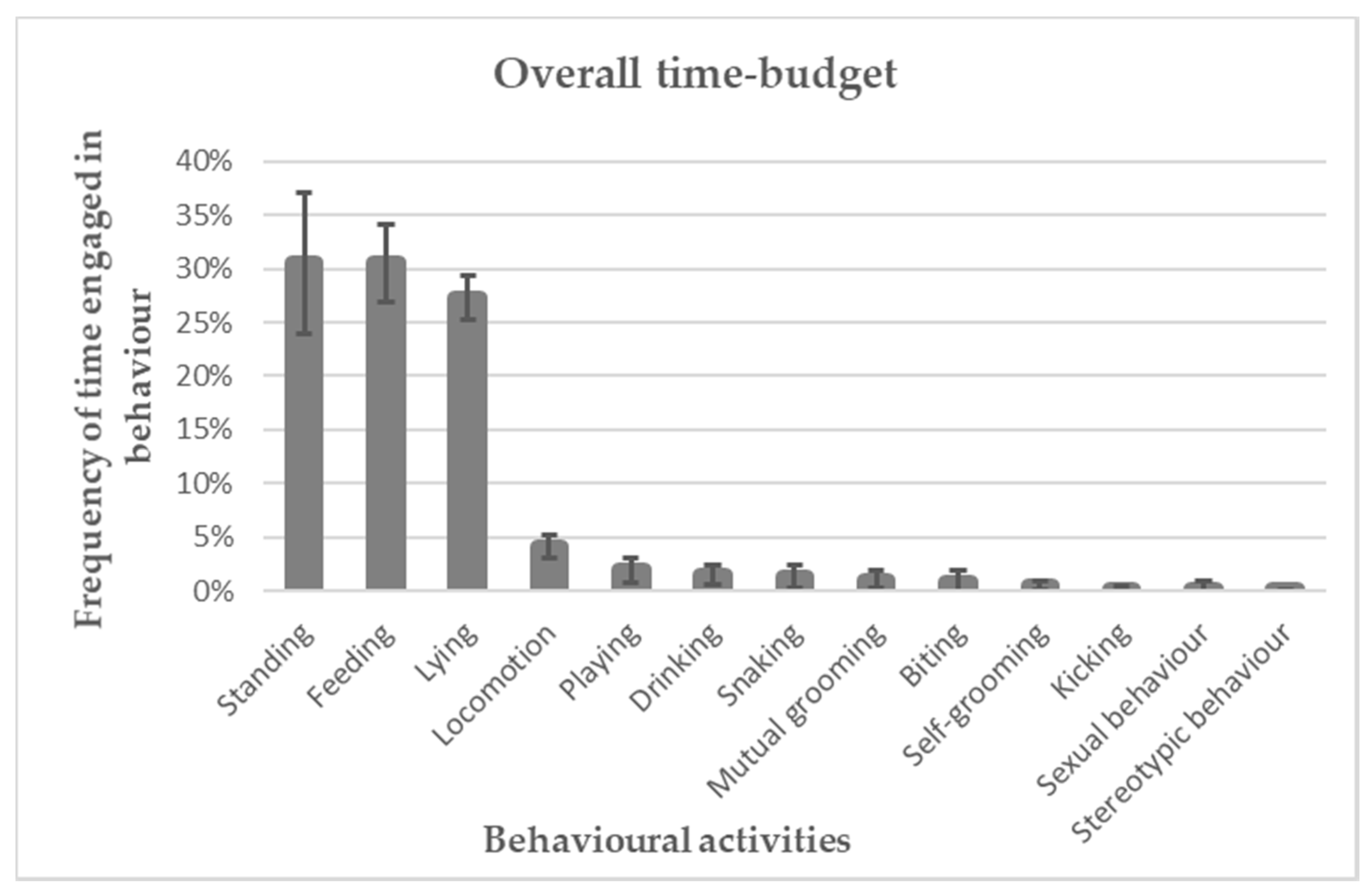

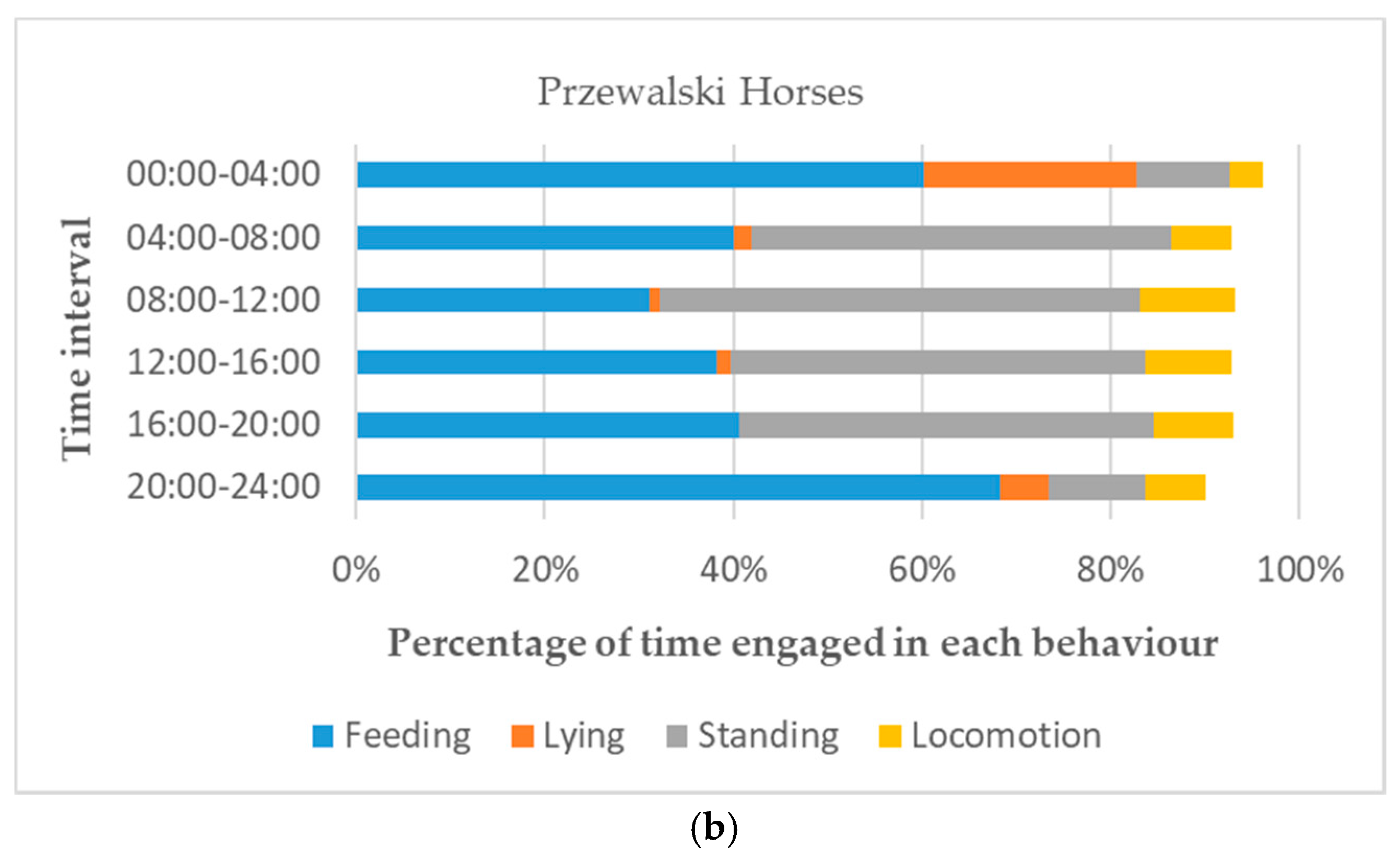
| Id Pen | N of Horses | Pen Area (m2) | Stocking Density (m2/horse) | Space at the Feed Bunk (m/horse) |
|---|---|---|---|---|
| A | 8 | 35.00 | 4 | 0.88 |
| B | 8 | 36.75 | 5 | 0.61 |
| C | 6 | 36.00 | 6 | 0.80 |
| Activities | Descriptions | Illustrations |
|---|---|---|
| Self-grooming | The horse performs body cleaning by himself. It includes: shaking the entire body or a part of it (a); nibbling or licking the coat hair (b); rolling on the ground (c); rubbing parts of the body against objects (d) or other parts of the body (e.g., rubbing the muzzle against the limbs) (e). | 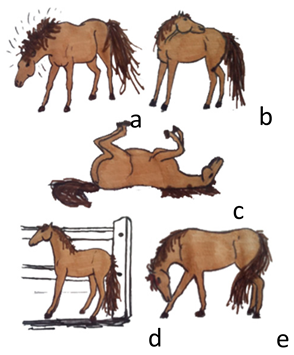 |
| Mutual grooming | Body cleaning is performed reciprocally or by one horse towards a conspecific. | 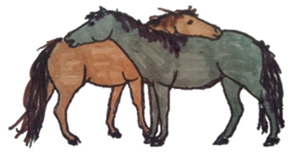 |
| Lying | The horse is lying on the ground in the sternal position with the limbs flexed below the body (f) or in lateral position with extended limbs (g). |  |
| Playing | The horse plays alone or with other horses. It includes: play with structural parts of the pen (h), sexual play (i), locomotor play (l), and play fighting (m). | 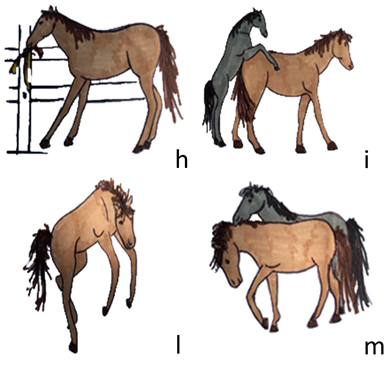 |
| Locomotion | The horse moves inside the pen by taking steps; the neck is in a horizontal position (n) or lowered to the ground to sniff (o). |  |
| Feeding | The horse eats hay, straw or feedstuff in the trough or on the ground. |  |
| Drinking | The horse drinks. | 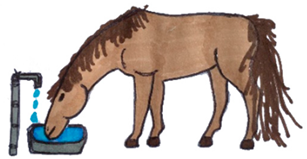 |
| Standing | The horse is in quadrupedal station. The expression is relaxed or attentive. It includes: “standing alert” (p) and “standing relaxed” (q). | 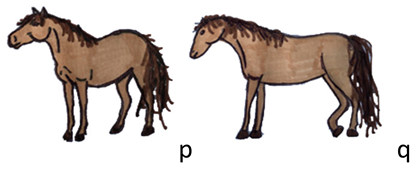 |
| Snaking | The horse stretches its neck towards a conspecific with the ears turned backwards, the lips are often closed and the body is in a dominant position. | 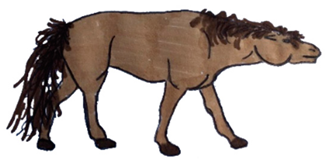 |
| Kicking | The horse lifts one (r) or both hind limbs (s) off the ground and quickly stretches it/them towards a conspecific, aiming to hit him. |  |
| Biting | The horse quickly opens and closes its mouth and its teeth touch the body of a conspecific, aiming to bite him. The ears are turned backwards. | 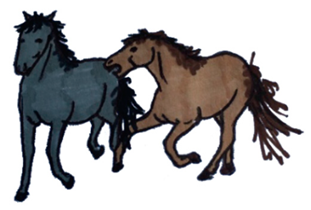 |
| Sexual behaviour | The stallion sniffs or bites the mare’s genitals (t). The stallion mounts the mare: erection and penetration are present (u). | 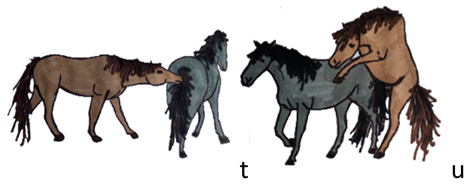 |
| Stereotypic behaviour | The horse expresses a stereotyped behaviour: both oral (v) and locomotor stereotypes (z) are considered. | 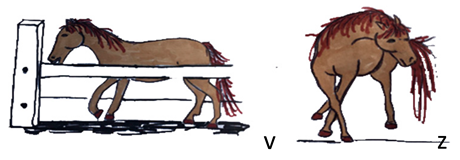 |
| Behavioural Activities | Stocking Density | |||||
|---|---|---|---|---|---|---|
| %/24 h | %/12 Light Hours | %/12 Dark Hours | ||||
| ra | p-Value | ra | p-Value | ra | p-Value | |
| Standing | −0.61 | 0.079 | −0.51 | 0.157 | −0.68 | 0.049 * |
| Feeding | −0.23 | 0.559 | −0.14 | 0.724 | −0.32 | 0.396 |
| Lying | 0.59 | 0.094 | −0.08 | 0.839 | 0.57 | 0.112 |
| Locomotion | 0.89 | 0.001 * | 0.76 | 0.017 * | 0.67 | 0.049 * |
| Playing | 0.73 | 0.024 * | 0.79 | 0.012 * | 0.29 | 0.444 |
| Drinking | −0.29 | 0.450 | −0.56 | 0.114 | 0.00 | 0.997 |
| Snaking | 0.23 | 0.553 | 0.28 | 0.461 | 0.04 | 0.911 |
| Mutual grooming | 0.29 | 0.449 | 0.28 | 0.473 | 0.17 | 0.659 |
| Biting | 0.36 | 0.346 | 0.29 | 0.450 | 0.39 | 0.301 |
| Self-grooming | 0.76 | 0.018 * | 0.78 | 0.014 * | 0.48 | 0.193 |
| Kicking | 0.35 | 0.361 | 0.37 | 0.330 | 0.10 | 0.807 |
| Sexual behaviour | 0.38 | 0.317 | 0.39 | 0.297 | 0.00 | 1.000 |
| Stereotypic behaviour | 0.43 | 0.244 | 0.43 | 0.244 | 0.43 | 0.244 |
| Behavioural Activities (%) | Overall Time-Budget | 00:00–04:00 | 04:00–08:00 | 08:00–12:00 | 12:00–16:00 | 16:00–20:00 | 20:00–24:00 |
|---|---|---|---|---|---|---|---|
| Standing | 30.56 ± 6.56 | 26.33 ± 4.05 | 26.01 ± 4.31 | 29.40 ± 6.99 | 32.67 ± 6.93 | 41.06 ± 1.48 | 27.86 ± 6.64 |
| Feeding | 30.55 ± 3.59 | 20.14 ± 2.12 | 13.43 ± 4.96 | 43.11 ± 3.65 | 31.94 ± 3.40 | 38.74 ± 5.64 | 35.94 ± 4.19 |
| Lying | 27.33 ± 2.05 | 46.61 ± 1.19 | 51.48 ± 6.79 | 10.30 ± 5.10 | 21.38 ± 0.93 | 4.46 ± 2.13 | 29.77 ± 2.61 |
| Locomotion | 4.07 ± 1.06 | 3.07 ± 1.63 | 3.01 ± 0.75 | 7.38 ± 4.66 | 2.95 ± 0.15 | 5.70 ± 4.26 | 2.34 ± 1.71 |
| Playing | 1.97 ± 1.16 | 0.58 ± 1.00 | 1.56 ± 0.90 | 3.36 ± 3.03 | 3.13 ± 1.04. | 3.04 ± 2.12 | 0.17 ± 0.30 |
| Drinking | 1.51 ± 0.86 | 1.22 ± 0.91 | 1.19 ± 0.58 | 1.59 ± 1.18 | 2.03 ± 1.10 | 0.90 ± 0.62 | 2.17 ± 0.66 |
| Snaking | 1.27 ± 1.07 | 0.43 ± 0.54 | 1.33 ± 0.99 | 2.08 ± 0.90 | 1.24 ± 1.04 | 2.11 ± 1.72 | 0.43 ± 0.54 |
| Mutual grooming | 1.07 ± 0.85 | 0.69 ± 1.20 | 1.04 ± 0.90 | 1.01 ± 0.95 | 1.74 ± 1.59 | 1.56 ± 1.38 | 0.38 ± 0.39 |
| Biting | 0.84 ± 1.00 | 0.43 ± 0.54 | 0.78 ± 1.14 | 0.81 ± 0.56 | 1.22 ± 1.08 | 1.50 ± 1.12 | 0.29 ± 0.27 |
| Self-grooming | 0.52 ± 0.37 | 0.49 ± 0.43 | 0.17 ± 0.30 | 0.64 ± 0.70 | 0.93 ± 0.70 | 0.49 ± 0.22 | 0.41 ± 0.36 |
| Kicking | 0.19 ± 0.22 | 0.00 ± 0.00 | 0.00 ± 0.00 | 0.20 ± 0.18 | 0.55 ± 0.74 | 0.26 ± 0.26 | 0.12 ± 0.20 |
| Sexual behaviour | 0.07 ± 0.08 | 0.00 ± 0.00 | 0.00 ± 0.00 | 0.12 ± 0.20 | 0.12 ± 0.20 | 0.17 ± 0.15 | 0.00 ± 0.00 |
| Stereotypic behaviour | 0.04 ± 0.12 | 0.00 ± 0.00 | 0.00 ± 0.00 | 0.00 ± 0.00 | 0.12 ± 0.20 | 0.00 ± 0.00 | 0.12 ± 0.20 |
© 2020 by the authors. Licensee MDPI, Basel, Switzerland. This article is an open access article distributed under the terms and conditions of the Creative Commons Attribution (CC BY) license (http://creativecommons.org/licenses/by/4.0/).
Share and Cite
Raspa, F.; Tarantola, M.; Bergero, D.; Nery, J.; Visconti, A.; Mastrazzo, C.M.; Cavallini, D.; Valvassori, E.; Valle, E. Time-Budget of Horses Reared for Meat Production: Influence of Stocking Density on Behavioural Activities and Subsequent Welfare. Animals 2020, 10, 1334. https://doi.org/10.3390/ani10081334
Raspa F, Tarantola M, Bergero D, Nery J, Visconti A, Mastrazzo CM, Cavallini D, Valvassori E, Valle E. Time-Budget of Horses Reared for Meat Production: Influence of Stocking Density on Behavioural Activities and Subsequent Welfare. Animals. 2020; 10(8):1334. https://doi.org/10.3390/ani10081334
Chicago/Turabian StyleRaspa, Federica, Martina Tarantola, Domenico Bergero, Joana Nery, Alice Visconti, Chiara Maria Mastrazzo, Damiano Cavallini, Ermenegildo Valvassori, and Emanuela Valle. 2020. "Time-Budget of Horses Reared for Meat Production: Influence of Stocking Density on Behavioural Activities and Subsequent Welfare" Animals 10, no. 8: 1334. https://doi.org/10.3390/ani10081334
APA StyleRaspa, F., Tarantola, M., Bergero, D., Nery, J., Visconti, A., Mastrazzo, C. M., Cavallini, D., Valvassori, E., & Valle, E. (2020). Time-Budget of Horses Reared for Meat Production: Influence of Stocking Density on Behavioural Activities and Subsequent Welfare. Animals, 10(8), 1334. https://doi.org/10.3390/ani10081334








